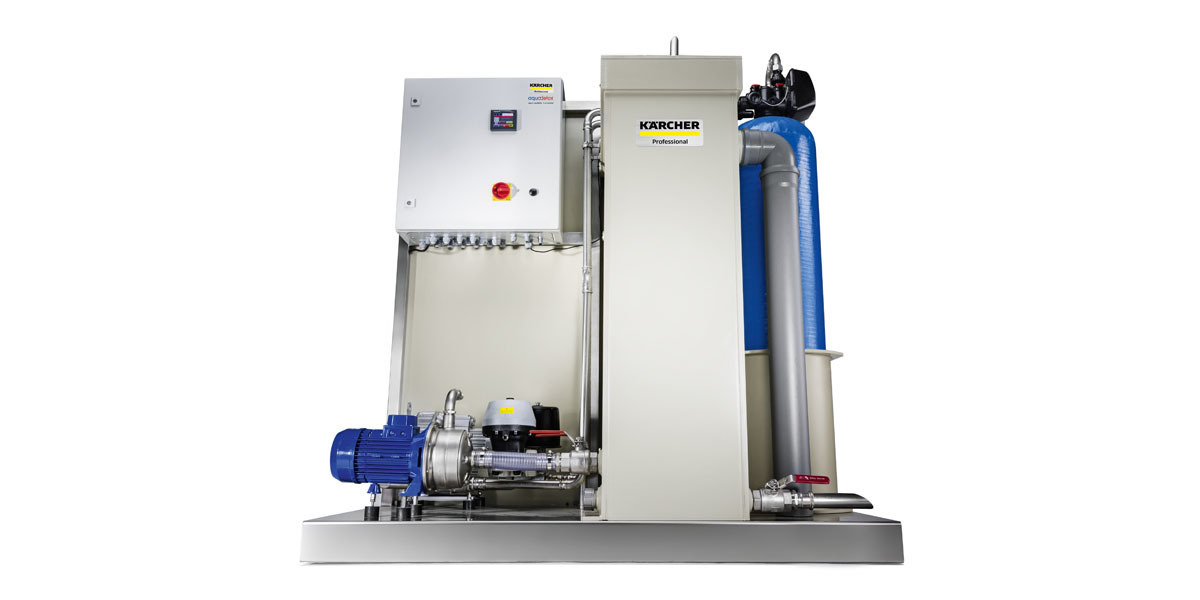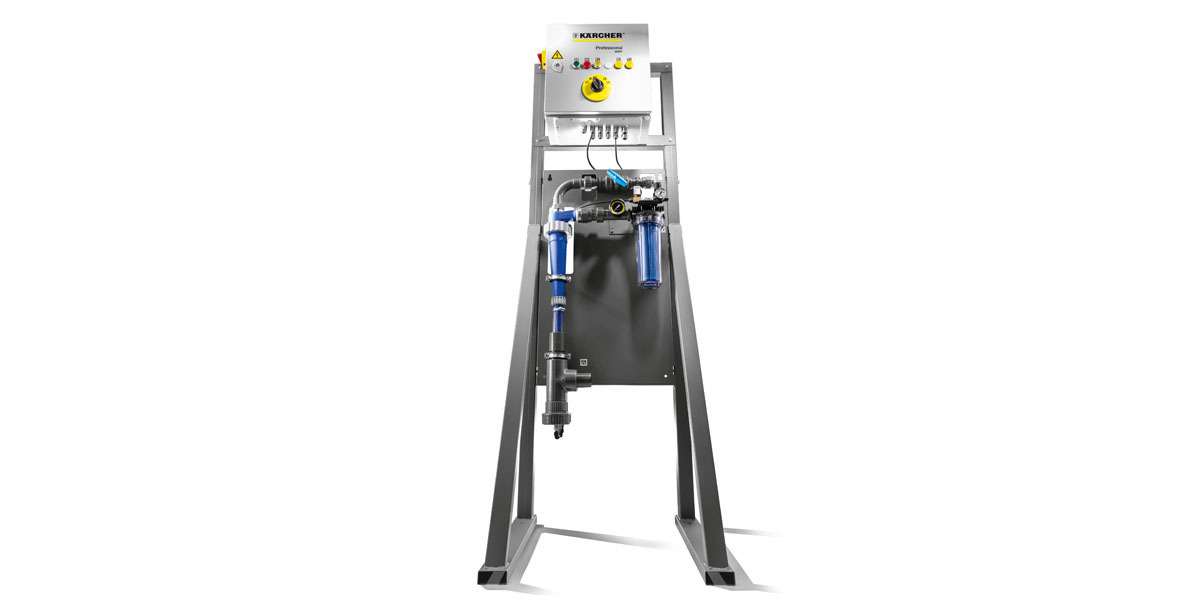Water reclamation in wash systems
Water reclamation has become standard practice today in vehicle wash systems. High ecological, economical, structural and legal requirements are placed on the recycling plants – for safe operation, a worthwhile investment and a sustainable solution. Because up to 98 per cent fresh water can be saved with a water treatment system. This not only offers operators of wash systems, tunnel vehicle wash systems and car wash parks a clean solution for water reclamation, but also significantly reduces operating costs.

Water treatment systems: Good for operators and the environment
A regular visit to a vehicle wash system is a must for many vehicle owners. Apart from safety reasons and preserving the value of the wheels, appearance is generally why many drivers attach importance to a clean car. Where the water comes from and what happens to it afterwards is generally irrelevant for many people. However, for owners/operators of gantry and self-service wash systems, this issue can make a significant contribution to the profitability of the system.
On average 150 to 350 litres of water are required in vehicle wash systems per vehicle wash, depending on the system equipment and selected wash programme. With self-service washing stations, the average water demand is roughly 80 litres per wash. This is not only expensive, but also harms the environment. Especially if fresh water is used for every wash. Modern treatment systems help with water reclamation and keep the water required for the vehicle wash circulating in the closed loop. The waste water can largely be reused. Only small amounts of fresh water are required, the rest is reclaimed water. With efficient systems, up to 98 per cent fresh water can be saved per wash. The benefits of investing in water treatment systems are therefore twofold: For the owner/operator and for the environment.

Different types of water treatment system
There are a number of recycling systems to consider for wash bays and gantry car washes: Biological water treatment systems, sand filters or cyclone separators.
Systems for water treatment generally comprise an underground basin system and the aboveground components including reclaimed water tank.
- In the first stage, the waste water from the vehicle wash is fed to an adequately dimensioned settling pit (sludge trap). There, suspended particles carried along in the wash water are separated.
- Depending on the system, this is then followed by one or two biological stages, or a ventilated pump pit is used. From there, the aboveground components are supplied with water.
Biological water treatment systems
Biological water treatment systems provide a way to treat wash water in an efficient and environmentally friendly manner. The water treatment is realised by natural processes using microorganisms. In contrast to physical methods, other waste water streams, e.g., from engine washes or self-service washing stations, can also be treated. The waste water is turned into clear reclaimed water thanks to the decomposition capacity of the microorganisms. As a result, up to 98 per cent of the fresh water can be saved.

Sand filter systems for the treatment of oil-free waste water
Sand filter recycling systems are used for the treatment of oil-free waste water, as produced during the machine wash programme of vehicles. Only small, temporary inputs of oil are tolerated by the system.

Water treatment with cyclone separators
Another physical system for waste water treatment in vehicle wash systems are cyclone separators. To treat the water, centrifugal force is used to separate dirt particles from the wash water.
Making the right choice
A comparison of potential methods shows that biological water treatment has a number of benefits. The wash water, which is treated in an efficient and environmentally friendly manner, is completely crystal clear and odour-free and, as regards the quality of the reclaimed water, significantly better than with physical methods.
In contrast to sand filter or cyclone separator water reclamation systems, biological treatment systems require a slightly greater effort as the microorganisms have to be supplied with sufficient oxygen. However, this is compensated by the significantly better quality of the reclaimed water and the large range of application.
One disadvantage of the physical systems is the slightly lower quality of the treated recycling water compared with biological treatment systems, as cleaning agent residues are not removed. In addition, in contrast to biological systems, only waste water from vehicle wash systems can be treated.
Systems for washing commercial vehicles
Water treatment systems are also available to the same extent for truck wash systems. They only differ from the car wash systems in terms of water consumption and pit size.


Cleaning commercial vehicles
Having clean commercial vehicles plays a key role in the positive look of a fleet. To save both labour costs and time, the demands on washing quality and speed are high. The size and design of the vehicles, however, not only require a special technology for the wash – the washing chemicals must also be right in order to clean trucks, buses, etc. cost-effectively.
Legal conditions: Owners/operators should consider the following
Before purchasing and installing a water treatment system, the legal conditions – building permits and operating licences for vehicle wash systems and waste water systems – should always be checked. In some countries, e.g., in Germany and Austria, water reclamation systems are a legal requirement for the construction of vehicle wash systems.
Water permit for the entire system
There are two options in Germany with regard to the discharge of waste water. The first option is a water permit for the entire system. For this, the owner/operator of the system needs to submit an application with all necessary documentation to the relevant water authorities. The water authorities issue the permit for operating the system after a review and positive assessment.
Installation of a design-approved water reclamation system
The second alternative for the discharge of waste water: Installation of a design-approved water reclamation system. In this case, the owner/operator informs the water authorities that they operate a system in accordance with a type approval, whereby no further inspections and permits are required. The systems provided by Kärcher for this range of application have the necessary type approval.
Existing vehicle wash systems
For existing vehicle wash systems, the owner/operator and water authorities decide whether the subsequent installation of a recycling system is appropriate – under ecological and economical aspects.

Tip: Choosing reliable water treatment systems
Apart from compliance with all regulations, the focus should also be on the quality and reliability of the water reclamation system when making the decision to buy. After all, if the water treatment system is defective, the entire system comes to a standstill. The individual components must be robust and easy to maintain. A status display should also be able to inform the owner/operator at any time about the maintenance condition and possible causes of faults or malfunctions. The service by the manufacturer of the system is also important in this respect. A comprehensive network of customer service centres and service technicians, who are on-site within 24 hours, and fast spare parts supply minimise downtimes and maintenance times. Maintenance service contracts, a hotline and regular information round off the service offering – for the satisfaction of customers and system owners/operators.






